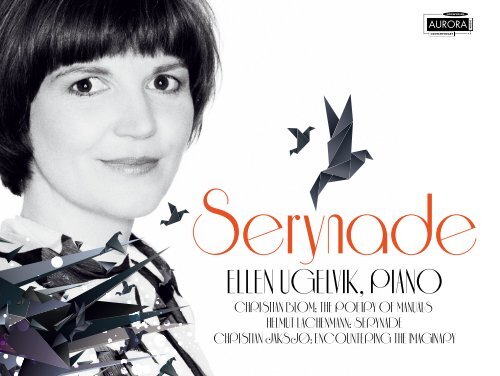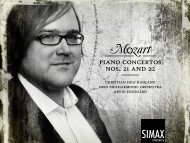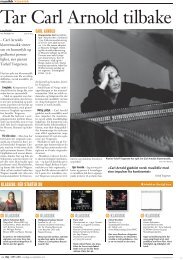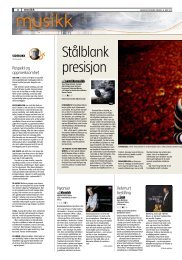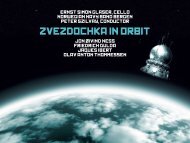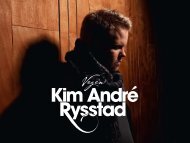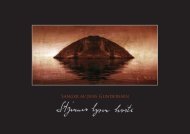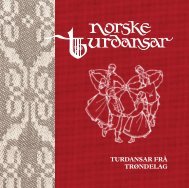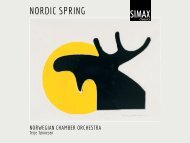ELLEN UGELVIK, PIANO
ELLEN UGELVIK, PIANO
ELLEN UGELVIK, PIANO
Create successful ePaper yourself
Turn your PDF publications into a flip-book with our unique Google optimized e-Paper software.
Serynade<br />
<strong>ELLEN</strong> <strong>UGELVIK</strong>, <strong>PIANO</strong><br />
CHRISTIAN BLOM: THE POETRY OF MANUALS<br />
HELMUT LACHENMANN: SERYNADE<br />
CHRISTIAN JAKSJØ: ENCOUNTERING THE IMAGINARY
1. CHRISTIAN BLOM<br />
The poetry of manuals<br />
— 13:01<br />
— MIC<br />
2. HELMUT LACHENMANN<br />
Serynade<br />
— 23:12<br />
—<br />
BREITKOPF & HÄRTEL<br />
3. CHRISTIAN JAKSJØ<br />
Encountering the Imaginary [Ulysses]<br />
– for ring modulated electromechanically amplified piano and electronic sound<br />
— 24:00<br />
— MIC<br />
M<br />
Encou<br />
f<br />
<strong>ELLEN</strong> <strong>UGELVIK</strong>, <strong>PIANO</strong><br />
When does the p<br />
great virtuoso<br />
Etude flawlessly<br />
pianist only scra<br />
making a gratin<br />
knocks on the w<br />
who doesn't pla<br />
2
CHRISTIAN BLOM<br />
Manualenes poesi (2007–11) for piano<br />
HELMUT LACHENMANN<br />
Serynade (1998/2000) for piano<br />
CHRISTIAN JAKSJØ<br />
Encountering the Imaginary [Ulysses] (2009/10)<br />
for ring modulated electromechanically<br />
amplified piano and electronic sound<br />
—<br />
BY BJÖRN GOTTSTEIN<br />
—<br />
When does the piano become a piano? Only when a<br />
great virtuoso performs Chopin's Revolutionary<br />
Etude flawlessly and magnificently on it? What if the<br />
pianist only scrapes his fingernails along the keys,<br />
making a grating sound? How about a pianist who<br />
knocks on the wood of the instrument? Or a pianist<br />
who doesn't play at all?<br />
The certainty with which the piano has been played<br />
and listened to up until the middle of the 20th century<br />
has been upset by the music of the avant-garde. A<br />
composer writing a piece for the piano today has to<br />
deal with the fact that striking a key is only one of<br />
many options. Yet the pianist in Helmut Lachenmann's<br />
piece Serynade is still expected to treat the piano in a<br />
3
conventional manner. The historical dialectics of the<br />
instrument itself, the inescapable conflict of being an<br />
expensive piece of furniture assuring the bourgeois<br />
self-conception on the one hand, and being a<br />
laboratory of sound experiment and aesthetic change<br />
on the other, may never be resolved. It is rather within<br />
this conflict that the prospects of contemporary piano<br />
music unfold. Many of the earlier pieces Lachenmann<br />
has written for the piano have exposed single aspects<br />
of the instrument, like the grating sound in Guero<br />
(1970) or the isolation of different parameters and filter<br />
effects in Ein Kinderspiel (1980).<br />
Serynade is actually the first large-scale piece<br />
Lachenmann has written for piano solo. The title refers<br />
to a genre of light music to be performed outdoors<br />
and/or in the evening, related to the ständchen and the<br />
divertimento. (The misspelling "y" in the title refers to<br />
the dedicatee of the piece, Yukiko Sugawara.) There is<br />
in fact a lightness and leisure to be found in this piece.<br />
The glissando from the bottom to the top of the<br />
keyboard is really just for show, a gesture hardly to be<br />
taken seriously as material; it expresses nothing but<br />
the bold manner in which something is brushed away.<br />
The question remains of what happens to the music<br />
that Lachenmann evokes. Almost all the figures and<br />
techniques Lachenmann uses have been explored and<br />
contextualized. He is thus not inventing anything from<br />
a technical point of view, instead the question he<br />
seems to be asking recalls Arnold Schoenberg's<br />
question when he was told that many young<br />
composers were using his dodecaphonic method:<br />
"Yes, but do they also make music?"<br />
One may listen to Lachenmann's Serynade as an<br />
essay on musical expression. Can a musical gesture<br />
that has been coded with meaning be used in an<br />
original, genuine way? The answer is of course yes,<br />
as 600 years of keyboard music have proved. Yet<br />
Lachenmann's focus seems to point further and<br />
further into the piano itself, as if he is directing his<br />
musical imagination into the nooks of the instrument,<br />
searching for a residue of resonance within the<br />
vibrating wood. One of the figures central to<br />
Lachenmann's piece is the sound shadow cast when<br />
a silently struck piano string vibrates sympathetically.<br />
This effect reveals the gap between the façade of<br />
sound, the outspokenness of the struck key, and its<br />
inner life.<br />
In Manualenes poesi Christian Blom uses the same<br />
effect to conceal the poetic core of the music behind<br />
a wall of staccato clusters. Of course, the clusters in<br />
the foreground are themselves musical and not just a<br />
disturbance, they are dry and hard and without<br />
humour. The chords that sound sympathetically are<br />
made possible by this façade of sounds in the first<br />
place. Still the essence of the music does not unfold in<br />
the forefront, it has been moved to the periphery of not<br />
only the instrument, but of the listening radius<br />
altogether. "Do you understand?" he asks the pianist<br />
when the second part, a Satie-like arrangement of<br />
chords, begins. "Understand" that the keys that are<br />
now struck correspond with the ghost sounds from<br />
the first part. When Jacques Derrida developed the<br />
idea of “hauntology” he was not thinking about music.<br />
Yet the idea of a haunting of ideas and sounds<br />
undercutting the musical present has been adapted<br />
by many com<br />
decade. The li<br />
also means that<br />
to put it solemn<br />
It is not alwa<br />
interesting let a<br />
Among the gho<br />
the haunting vo<br />
exposed to. It i<br />
driven mad by m<br />
the Imaginary<br />
regions of soun<br />
listener (for th<br />
preludes the sc<br />
describing the<br />
4
ynade as an<br />
usical gesture<br />
be used in an<br />
of course yes,<br />
e proved. Yet<br />
t further and<br />
s directing his<br />
the instrument,<br />
ce within the<br />
s central to<br />
ow cast when<br />
ympathetically.<br />
the façade of<br />
ck key, and its<br />
uses the same<br />
music behind<br />
the clusters in<br />
l and not just a<br />
and without<br />
athetically are<br />
ds in the first<br />
es not unfold in<br />
eriphery of not<br />
tening radius<br />
sks the pianist<br />
rrangement of<br />
keys that are<br />
t sounds from<br />
developed the<br />
g about music.<br />
s and sounds<br />
been adapted<br />
by many composers and artists within the last<br />
decade. The listening of elsewhere and elsewhen<br />
also means that we are shifting perspectives, that we,<br />
to put it solemnly, are pushing frontiers.<br />
It is not always the loudest who are the most<br />
interesting let alone the most intelligent to listen to.<br />
Among the ghosts of the past we most certainly find<br />
the haunting voices of the Sirens that Ulysses was<br />
exposed to. It is, of course, an aspiring claim to be<br />
driven mad by music. Christian Jaksjø's Encountering<br />
the Imaginary [Ulysses] is an attempt to access<br />
regions of sound that have been withdrawn from the<br />
listener (for the sake of his own safety). Jaksjø<br />
preludes the score with a text by Maurice Blanchot,<br />
describing the song of the Sirens as unfulfilling yet<br />
being "a sign of where the real sources and real<br />
happiness of song opened", and the text seems like an<br />
antedated description of Jaksjø's piece, in which the<br />
instrument is engaged in a self-modulating song<br />
through an elaborate electro-acoustic exchange<br />
between the played piano part and an electronic<br />
soundtrack. There is also a close connection between<br />
Jaksjø's Encountering the Imaginary and<br />
Lachenmann's Serynade, the material of the former<br />
having been derived from the latter, exposing those<br />
sounds that Lachenmann only hinted at. But more<br />
than being a frottage of Lachenmann's piece Jaksjø<br />
has tapered the project of listening deeply and<br />
beyond, turning the piano into a guidepost that leads<br />
well into the 21st century.<br />
5
CHRISTIAN BLOM<br />
Manualenes poesi (2007–11) for klaver<br />
HELMUT LACHENMANN<br />
Serynade (1998/2000) for klaver<br />
CHRISTIAN JAKSJØ<br />
Encountering the Imaginary [Ulysses] (2009/10)<br />
for ringmodulert elektromekanisk forsterket klaver<br />
og elektronisk lyd<br />
Når blir klaveret til et klaver? Utelukkende når en<br />
stor virtuos framfører Chopins Revolusjonsetyde på<br />
det, feilfritt og imponerende? Hva hvis pianisten bare<br />
gnir fingerneglene sine langs tangentene med en<br />
skrapende lyd? Hva med pianisten som dunker på<br />
treet i instrumentkroppen? Hva med pianisten som<br />
ikke spiller overhodet?<br />
—<br />
AV BJÖRN GOTTSTEIN<br />
—<br />
Fram til midten av det 20. århundre er klaveret blitt spilt<br />
på og lyttet til med en sikkerhet som avantgarden<br />
deretter forstyrret. En komponist som vil skrive for<br />
klaver i dag, må forholde seg til at det å trykke ned<br />
tangenter bare er en av mange muligheter. Likevel<br />
forventes det at pianisten i Helmut Lachenmanns verk<br />
Serynade også kan behandle instrumentet innenfor<br />
konvensjonelle<br />
som er gitt a<br />
konflikten mello<br />
borgerlig selvfo<br />
laboratorium fo<br />
utvikling på den<br />
på innsiden av<br />
tids musikk for k<br />
stykkene Lache<br />
fram enkeltstå<br />
som den skra<br />
isolasjonen av u<br />
Ein Kinderspiel<br />
Serynade er fa<br />
Lachenmann sk<br />
lettere musikk fr<br />
slekt med form<br />
(Den feilstaven<br />
som verket er<br />
lette og frie finn<br />
fra de dype til<br />
show-off, en ge<br />
materiale; den<br />
forsøk på å børs<br />
med, er hva som<br />
framkaller. Næ<br />
Lachenmann be<br />
plassert i en sa<br />
teknisk sett ikke<br />
han tilsynelate<br />
Schönberg stilt<br />
komponister til<br />
«Ja, men lager<br />
6
10)<br />
aver<br />
averet blitt spilt<br />
avantgarden<br />
vil skrive for<br />
t å trykke ned<br />
gheter. Likevel<br />
enmanns verk<br />
ntet innenfor<br />
konvensjonelle rammer. Den historiske dialektikken<br />
som er gitt av klaveret selv, den uomgjengelige<br />
konflikten mellom å være et dyrt møbel som bekrefter<br />
borgerlig selvforståelse på den ene siden, og et<br />
laboratorium for klanglige eksperimenter og estetisk<br />
utvikling på den andre, er umulig å løse. Det er snarere<br />
på innsiden av denne konflikten at mulighetene i vår<br />
tids musikk for klaver utfolder seg. Mange av de tidlige<br />
stykkene Lachenmann har skrevet for klaver, viser<br />
fram enkeltstående egenskaper ved instrumentet,<br />
som den skrapende lyden i Guero (1970) eller<br />
isolasjonen av ulike parametre og filtreringseffekter i<br />
Ein Kinderspiel (1980).<br />
Serynade er faktisk det første verket i stor skala<br />
Lachenmann skrev for klaver solo. Tittelen henviser til<br />
lettere musikk framført utendørs og/eller om kvelden, i<br />
slekt med former som ständchen og divertimento.<br />
(Den feilstavende «y»-en i tittelen viser til utøveren<br />
som verket er tilegnet, Yukiko Sugawara.) Både det<br />
lette og frie finnes virkelig i dette stykket. Glissandoen<br />
fra de dype til de lyse tangentene nærmer seg en<br />
show-off, en gest det er vanskelig å ta alvorlig som<br />
materiale; den uttrykker ikke annet enn et dristig<br />
forsøk på å børste noe vekk. Spørsmålet vi sitter igjen<br />
med, er hva som hender med musikken Lachenmann<br />
framkaller. Nær sagt alle figurer og teknikker<br />
Lachenmann benytter seg av, er allerede utforsket og<br />
plassert i en sammenheng. Slikt sett oppfinner han<br />
teknisk sett ikke noe nytt. I stedet minner spørsmålet<br />
han tilsynelatende stiller, om spørsmålet Arnold<br />
Schönberg stilte da han ble fortalt at mange unge<br />
komponister tilegnet seg tolvtoneteknikkene hans:<br />
«Ja, men lager de også musikk?»<br />
Man kan lytte til Lachenmanns Serynade som et<br />
essay i å uttrykke seg musikalsk. Kan en musikalsk<br />
gest som er ladet med mening, fortsatt brukes på en<br />
måte som vil bli oppfattet som original og ekte?<br />
Svaret er selvsagt ja, og 600 år med musikk for<br />
tangentinstrumenter beviser det. Likevel peker<br />
Lachenmann tilsynelatende videre, stadig lengre inn i<br />
klaveret, som om han leder sin musikalske fantasi inn<br />
i instrumentets innerste hjørner, på jakt etter rester av<br />
resonans inne i det vibrerende treet. En sentral figur i<br />
Lachenmanns stykke er skyggen lyden kaster når en<br />
av strengene i klaveret vibrerer sympatisk eller<br />
passivt, kun satt i bevegelse av vibrasjonen i de andre<br />
strengene. Denne effekten avslører avstanden<br />
mellom lydens fasade, selve det uttalte ved tangenten<br />
som blir slått an, og lydens indre liv.<br />
I Manualenes poesi bruker Christian Blom samme<br />
effekt til å skjule en poetisk kjerne i musikken bak en<br />
vegg av staccato clustre. Selvfølgelig er clustrene i<br />
forgrunnen også musikalske og ikke bare der for å<br />
forstyrre, de er tørre, harde og blottet for humor.<br />
Akkordene som klinger passivt hadde ikke vært<br />
mulige uten denne fasaden av lyd i første omgang.<br />
Likevel utfolder ikke det essensielle i denne musikken<br />
seg i forgrunnen, det er flyttet til utkanten, ikke bare av<br />
instrumentet, men av lyttingens radius overhodet.<br />
«Forstår du?» spør han pianisten, når annen del, et<br />
Satie-aktig arrangement av akkorder, begynner.<br />
«Forstår» at tangentene nå trykkes ned i samsvar med<br />
de spektrale klangene fra første del. Da Jacques<br />
Derrida utviklet begrepet om hauntology (av «haunt»,<br />
å hjemsøke), tenkte han ikke på musikk. Likevel har<br />
tanken om å sette ideer og lyder på prøve, på en måte<br />
7
What was the n<br />
its fault lie? Wh<br />
Some have alw<br />
song–a natural<br />
kinds?), but on<br />
possible way to<br />
that extreme de<br />
the normal con<br />
enchantment w<br />
reproduce the h<br />
som undergraver et musikalsk nå, blitt adoptert av<br />
mange komponister og kunstnere de siste ti årene. Å<br />
lytte annensteds og i en annen tid innebærer også at<br />
perspektivet skifter, at vi, for å si det høytidelig, flytter<br />
grenser.<br />
Det kraftigste er ikke alltid det mest interessante eller<br />
intelligente å lytte til. Sirenenes stemmer som<br />
hjemsøkte Ulysses, er utvilsomt skygger fra fortiden.<br />
De styrker ideen om at musikk kan drive mennesket<br />
fra forstanden. Christian Jaksjøs Encountering the<br />
Imaginary [Ulysses] prøver å skape tilgang til<br />
klanglige områder som er blitt unndratt lytteren (av<br />
sikkerhetshensyn). Som innledning til partituret har<br />
Jaksjø en tekst av Maurice Blanchot der sirenenes<br />
sang blir beskrevet som utilfredsstillende og samtidig<br />
«et tegn på hvor sangens virkelige kilder og gleder<br />
åpnet seg», og teksten virker som om den foregriper<br />
en beskrivelse av Jaksjøs stykke, der instrumentet<br />
engasjeres i en selvmodulerende sang gjennom en<br />
elektroakustisk utveksling mellom klaverstemmen og<br />
det elektroniske lydsporet. Det er også en nær<br />
sammenheng mellom Jaksjøs Encountering the<br />
Imaginary og Lachenmanns Serynade, i og med at<br />
materialet i det førstnevnte er utvunnet fra det<br />
sistnevnte og stiller ut de klangene som Lachenmann<br />
bare antydet eksistensen av. Men mer enn å være en<br />
overtegning av Lachenmanns verk, har Jaksjø<br />
fortsatt å gradbøye den dype lyttingen videre, og har<br />
gjort klaveret til en utkikkspost med utsikt langt inn i<br />
det 21. århundre.<br />
Enc<br />
The Sirens: it s<br />
unfulfilling way,<br />
real sources an<br />
by means of th<br />
song still to com<br />
space where s<br />
deceive him, in<br />
But what happ<br />
What was this<br />
left but to disap<br />
source and o<br />
completely than<br />
where, ears blo<br />
Sirens, as proof<br />
disappear.<br />
8
lder og gleder<br />
den foregriper<br />
r instrumentet<br />
g gjennom en<br />
erstemmen og<br />
også en nær<br />
ountering the<br />
e, i og med at<br />
unnet fra det<br />
Lachenmann<br />
enn å være en<br />
, har Jaksjø<br />
videre, og har<br />
tsikt langt inn i<br />
Encountering the Imaginary<br />
The Sirens: it seems they did indeed sing, but in an<br />
unfulfilling way, one that only gave a sign of where the<br />
real sources and real happiness of song opened. Still,<br />
by means of their imperfect songs that were only a<br />
song still to come, they did lead the sailor toward that<br />
space where singing might truly begin. They did not<br />
deceive him, in fact: they actually led him to his goal.<br />
But what happened once the place was reached?<br />
What was this place? One where there was nothing<br />
left but to disappear, because music, in this region of<br />
source and origin, had itself disappeared more<br />
completely than in any other place in the world: sea<br />
where, ears blocked, the living sank, and where the<br />
Sirens, as proof of their good will, had also, one day, to<br />
disappear.<br />
What was the nature of the Sirens’ song? Where did<br />
its fault lie? Why did this fault make it so powerful?<br />
Some have always answered: It was an inhuman<br />
song–a natural noise no doubt (are there any other<br />
kinds?), but on the fringes of nature, foreign in every<br />
possible way to man, very low, and awakening in him<br />
that extreme delight in falling that he cannot satisfy in<br />
the normal conditions of life. But, say others, the<br />
enchantment was stranger than that: it did nothing but<br />
reproduce the habitual song of men, and because the<br />
Sirens, who were only animals, quite beautiful<br />
because of the reflection of feminine beauty, could<br />
sing as men sing, they made the song so strange that<br />
they gave birth in anyone who heard it to a suspicion<br />
of the inhumanity of every human song. Is it through<br />
despair, then, that men passionate for their own song<br />
came to perish? Through a despair very close to<br />
rapture. There was something wonderful in this real<br />
song, this common, secret song, simple and everyday,<br />
that they had to recognize right away, sung in an<br />
unreal way by foreign, even imaginary powers, song<br />
of the abyss that, once heard, would open an abyss in<br />
each word and would beckon those who heard it to<br />
vanish into it.<br />
This song, we must remember, was aimed at sailors,<br />
men who take risks and feel bold impulses, and it was<br />
also a means of navigation: it was a distance, and it<br />
revealed the possibility of traveling this distance, of<br />
making the song into the movement toward the song,<br />
and of making this movement the expression of the<br />
greatest desire. Strange navigation, but toward what<br />
end? It has always been possible to think that those<br />
who approached it did nothing but come near to it, and<br />
died because of impatience, because they<br />
prematurely asserted: here it is; here, here I will cast<br />
9
anchor. According to others, it was on the contrary too<br />
late: the goal had already been passed; the<br />
enchantment, by an enigmatic promise, exposed men<br />
to being unfaithful to themselves, to their human song<br />
and even to the essence of the song, by awakening<br />
the hope and desire for a wonderful beyond, and this<br />
beyond represented only a desert, as if the<br />
motherland of music were the only place completely<br />
deprived of music, a place of aridity and dryness<br />
where silence, like noise, burned, in one who once<br />
had the disposition for it, all passageways to song.<br />
Was there, then, an evil principle in this invitation to<br />
the depths? Were the Sirens, as tradition has sought<br />
to persuade us, only the false voices that must not be<br />
listened to, the trickery of seduction that only disloyal<br />
and deceitful beings could resist?<br />
There has always been a rather ignoble effort among<br />
men to discredit the Sirens by flatly accusing them of<br />
lying: liars when they sang, deceivers when they<br />
sighed, fictive when they were touched; in every<br />
respect nonexistent, with a childish nonexistence that<br />
the good sense of Ulysses was enough to exterminate.<br />
treachery which led him to enjoy the entertainment of<br />
the Sirens, without risks and without accepting the<br />
consequences; his was a cowardly, moderate, and<br />
calm enjoyment, as befits a Greek of the decadent era<br />
who will never deserve to be the hero of the Iliad. His<br />
is a fortunate and secure cowardliness, based on<br />
privilege, which places him outside of the common<br />
condition–others having no right to the happiness of<br />
the elite, but only a right to the pleasure of watching<br />
their leader writhe ridiculously, with grimaces of<br />
ecstasy in the void, a right also to the satisfaction of<br />
mastering their master (that is no doubt the lesson<br />
they understood, the true song of the Sirens for them).<br />
Ulysses’ attitude, that surprising deafness of one who<br />
is deaf because he is listening, is enough to<br />
communicate to the Sirens a despair reserved till now<br />
for humans and to turn them, through this despair, into<br />
actual beautiful girls, real this one time only and<br />
worthy of their promise, thus capable of disappearing<br />
into the truth and profundity of their song.<br />
«Maurice Blanchot: The Book to Come»<br />
(Translated by Charlotte Mandell. Courtesy of Stanford University Press)<br />
It is true, Ulysses conquered them, but in what way?<br />
Ulysses, with his stubbornness and prudence, his<br />
10
tertainment of<br />
accepting the<br />
moderate, and<br />
e decadent era<br />
of the Iliad. His<br />
ess, based on<br />
f the common<br />
e happiness of<br />
re of watching<br />
grimaces of<br />
satisfaction of<br />
ubt the lesson<br />
irens for them).<br />
ss of one who<br />
is enough to<br />
served till now<br />
is despair, into<br />
time only and<br />
f disappearing<br />
g.<br />
»<br />
University Press)<br />
11
Christian Blom (1974) is an artist living on<br />
Nesoddtangen. He works with kinetic sculpture,<br />
mechanical devices and composition. Blom has a formal<br />
background as a guitarist and composer, counting a<br />
cand. philol in composition from the University of Bergen<br />
as a current academic highlight. Blom is constantly<br />
researching the parallells and differences in different<br />
media and their techniques. In particular on search for<br />
unexpected connections and perspectives.<br />
www.christianblom.com<br />
Christian Jaksjø’s musical background includes<br />
studies of improvisation, composition, and<br />
electro-acoustic music, an extensive performing<br />
career on trombone, euphonium, and related<br />
instruments, interdiciplinary experimental studies of<br />
dynamic form with architects, designers and<br />
engineers, along with a concurrent, groundbreaking<br />
creative practice as a composer: utilizing, for instance,<br />
processual musical transformation by means of<br />
discretely varying virtual n-tone equal-tempered<br />
divisions of the octave (Orthodrom/Loxodrom<br />
[Grosszirkelnavigation], 1997–2000); architecturized<br />
music composed algorithmically by means of complex<br />
dynamical systems operating directly on<br />
architectonical spatial structures by Jan Duiker<br />
(Ungrounded [Zonnestraal], 2002); stochastic<br />
algorithmic composition and sound synthesis directly<br />
operating on mystical texts by David Libeskind (The<br />
Four Texts, 2003) or also on the virtual instrumental<br />
resonance occurring in Helmut Lachenmann’s<br />
Serynade, and in the latter case combined with<br />
complex instrumental extension by means of ring<br />
Christian Blom (1974) er bosatt på Nesoddtangen.<br />
Han arbeider med kinetiske skulpturer, mekaniske<br />
innretninger og komposisjon. Blom har formell<br />
bakgrunn som gitarist og komponist med cand.<br />
philol i komposisjon fra Universitetet i Bergen som<br />
foreløpig akademisk høydepunkt. I sine prosjekter<br />
utforsker Blom forbindelser mellom ulike medier og<br />
deres teknikker. Med særlig blikk på uventede<br />
forbindelser og perspektiver.<br />
www.christianblom.com<br />
Christian Jaksjøs musikalske bakgrunn inkluderer<br />
studier i improvisasjon, komposisjon og<br />
elektroakustisk musikk, en omfattende karriere som<br />
utøver på trombone, euphonium og beslektede<br />
instrumenter, interdisiplinære eksperimentelle studier<br />
av dynamisk form med arkitekter, designere og<br />
ingeniører, ved siden av parallelt, banebrytende<br />
kreativt virke som komponist, uttrykt f.eks. gjennom:<br />
prosessuell musikalsk transformasjon ved hjelp av<br />
diskret varierende virtuelle n-toners tempereringer<br />
(Orthodrom/Loxodrom [Großzirkelnavigation],<br />
1997–2000); arkitektifisert musikk komponert<br />
algoritmisk ved hjelp av komplekse dynamiske<br />
systemer som opererer direkte på arkitektoniske<br />
romlige strukturer av Jan Duiker (Ungrounded<br />
[Zonnestraal], 2002); stokastisk algoritmisk<br />
komposisjon og lydsyntese som opererer direkte på<br />
mystiske tekster av David Libeskind (The Four Texts,<br />
2003), eller også på den virtuelle<br />
instrumentalresonansen slik den forekommer i Helmut<br />
Lachenmanns Serynade, og i dette tilfelle kombinert<br />
med en kompleks instrumental utvidelse ved hjelp av<br />
modulated elect<br />
feedback (Enco<br />
2009–2010). Pivo<br />
and as an impro<br />
forces as well a<br />
Christian Jaksjø<br />
was born in 197<br />
since 2003, play<br />
www.christianja<br />
Helmut Lachenm<br />
influential Europ<br />
early 21st centu<br />
Venice and Colo<br />
Beginning in the<br />
new and innova<br />
as temA (1968),<br />
(1969), for orche<br />
instruments and<br />
new sounds and<br />
instruments we<br />
questions past m<br />
postserialist com<br />
writings.<br />
Other works inc<br />
(1972), Accanto<br />
Estarrung) (1984<br />
(1984/85), Allegr<br />
for piano, and th<br />
A well-known te<br />
mentor to many<br />
12
soddtangen.<br />
, mekaniske<br />
r formell<br />
ed cand.<br />
Bergen som<br />
e prosjekter<br />
ike medier og<br />
ventede<br />
modulated electromechanical and electromagnetical<br />
feedback (Encountering the Imaginary [Ulysses],<br />
2009–2010). Pivotal to his work, both as a composer<br />
and as an improviser, is rendering audible: underlying<br />
forces as well as otherwise imperceptible patterns.<br />
Christian Jaksjø lives and works in Oslo (where he<br />
was born in 1973) and in Frankfurt am Main (where he,<br />
since 2003, plays trombone in the hr-Bigband).<br />
www.christianjaksjø.no<br />
ringmodulert elektromekanisk og elektromagnetisk<br />
tilbakekobling (Encountering the Imaginary [Ulysses],<br />
2009-10). Sentralt i hans virke, både som<br />
improviserende musiker og som komponist, er å gjøre<br />
hørbart: såvel bakenforliggende krefter som ellers<br />
uhørlige mønstre. Christian Jaksjø bor og arbeider i<br />
Oslo (hvor han ble født i 1973) og i Frankfurt am Main<br />
(hvor han, siden 2003, spiller trombone i hr-Bigband).<br />
www.christianjaksjø.no<br />
inkluderer<br />
karriere som<br />
lektede<br />
entelle studier<br />
nere og<br />
rytende<br />
ks. gjennom:<br />
ed hjelp av<br />
pereringer<br />
ation],<br />
nert<br />
amiske<br />
ektoniske<br />
unded<br />
isk<br />
er direkte på<br />
e Four Texts,<br />
mmer i Helmut<br />
lle kombinert<br />
e ved hjelp av<br />
Helmut Lachenmann (1935) is one of the most<br />
influential European composers of the late 20th and<br />
early 21st centuries. He studied with Luigi Nono in<br />
Venice and Cologne.<br />
Beginning in the late 1960s, Lachenmann explored a<br />
new and innovative musical language. In works such<br />
as temA (1968), for flute, voice and cello, and Air<br />
(1969), for orchestra and percussion soloist, he used<br />
instruments and voices unconventionally, producing<br />
new sounds and sound combinations in which all<br />
instruments were given equal weight. Lachenmann<br />
questions past musical assumptions in his many<br />
postserialist compositions and in his varied musical<br />
writings.<br />
Other works include the string quartet Gran Torso<br />
(1972), Accanto (1975/76), Mouvement (vor der<br />
Estarrung) (1984) for chamber orchestra, Ausklang<br />
(1984/85), Allegro Sostenuto (1986/88), Serynade (2000)<br />
for piano, and the opera The Little Match Girl (2001).<br />
A well-known teacher, Lachenmann has been a<br />
mentor to many important younger composers.<br />
Helmut Lachenmann (1935) er en av Europas mest<br />
innflytelsesrike komponister i det sene 20. og tidlige<br />
21. århundre. Han studerte med Luigi Nono i Venezia<br />
og i Köln.<br />
Mot slutten av 1960-årene begynte Lachenmann å<br />
utforske et helt nytt musikalsk språk. I verk som temA<br />
(1968), for fløyte, stemme og cello, og Air (1969), for<br />
orkester og solo slagverk, brukte han både<br />
instrumenter og stemmer på en ukonvensjonell måte,<br />
hvilket resulterte i nye klanger og klangkombinasjoner<br />
der samtlige instrumenter hadde likeverdige stemmer.<br />
Lachenmann setter spørsmålstegn ved tidligere<br />
musikalske antagelser i sine mange postserialistiske<br />
komposisjoner og artikler.<br />
På hans verkliste er bl.a. strykekvartetten Gran Torso<br />
(1972), Accanto (1975/76), Mouvement (vor der<br />
Estarrung) (1984) for kammerorkester, Ausklang<br />
(1984/85), Allegro Sostenuto (1986/88), Serynade (2000)<br />
for piano, og operaen Piken med svovelstikkene<br />
(2001). Lachenmann er også en høyt skattet lærer og<br />
mentor for unge komponister.<br />
13
Ellen Ugelvik c<br />
performing new<br />
composers. Sh<br />
the Grieg Acad<br />
Conservatorium<br />
Schleiermache<br />
Theater, Leipzig<br />
Ugelvik works a<br />
Europe, USA an<br />
festivals such a<br />
Internationalen<br />
Darmstadt, Ultra<br />
Huddersfield Co<br />
Muziekweek, M<br />
Nachts, Ultima C<br />
Borealis, ILIOS,<br />
Monday Evenin<br />
composers inclu<br />
Fujikura, Magne<br />
Jaksjø, Michael<br />
Birkelund, Claus<br />
Steen-Andersen<br />
Gadenstätter, H<br />
Ingvar Lidholm,<br />
Gjertsen.<br />
Her commitmen<br />
recognised. Sh<br />
performing arti<br />
in Norway. Her<br />
rewarded with<br />
member of the<br />
and Polygon.<br />
14
Ellen Ugelvik concentrates on discovering and<br />
performing new works by contemporary<br />
composers. She has studied with Einar Røttingen at<br />
the Grieg Academy in Bergen, Håkon Austbø at the<br />
Conservatorium van Amsterdam and Steffen<br />
Schleiermacher at the Hochschule für Musik und<br />
Theater, Leipzig.<br />
Ugelvik works as a soloist and chamber musician in<br />
Europe, USA and Asia. She has been invited to<br />
festivals such as Tasten – Berliner Klaviertage,<br />
Internationalen Ferienkurse für Neue Musik<br />
Darmstadt, Ultraschall, Gaudeamus, Rainy Days,<br />
Huddersfield Contemporary Music Festival, De Suite<br />
Muziekweek, Musik der Jahrhunderte; Südseite<br />
Nachts, Ultima Contemporary Music Festival,<br />
Borealis, ILIOS, Risør Festival of Chamber Music, and<br />
Monday Evening Concerts. She collaborates with<br />
composers including Helmut Lachenmann, Dai<br />
Fujikura, Magne Hegdal, Christian Blom, Christian<br />
Jaksjø, Michael Finnissy, Unsuk Chin, Therese<br />
Birkelund, Claus-Steffen Mahnkopf, Simon<br />
Steen-Andersen, Sven Lyder Kahrs, Clemens<br />
Gadenstätter, Helmut Oehring, Trond Reinholdtsen,<br />
Ingvar Lidholm, Nicholas A. Huber and Ruben S.<br />
Gjertsen.<br />
Her commitment to contemporary music is widely<br />
recognised. She recently received a state grant for<br />
performing artists, one of the most coveted awards<br />
in Norway. Her first solo album, Makrokosmos was<br />
rewarded with the Norwegian Grammy. She is a<br />
member of the ensembles asamisimasa, Jagerflygel<br />
and Polygon.<br />
Ellen Ugelvik er utdannet ved Konservatoriet i<br />
Amsterdam, Musikkhøyskolen i Leipzig og<br />
Griegakademiet i Bergen med Håkon Austbø,<br />
Steffen Schleiermacher og Einar Røttingen som<br />
veiledere.<br />
Ugelvik har fordypet seg i fremføring av<br />
samtidsmusikk og konserterer som solist og<br />
kammermusiker over hele verden. Hun har deltatt<br />
på samtidsmusikkfestivaler som Tasten – Berliner<br />
Klaviertage, Internationalen Ferienkurse für Neue<br />
Musik Darmstadt, Ultraschall, Gaudeamus, Rainy<br />
Days, Huddersfield Contemporary Music Festival,<br />
De Suite Muziekweek, Musik der Jahrhunderte;<br />
Südseite Nachts, Ultima, Borealis, ILIOS, Risør<br />
Kammermusikkfest og Monday Evening Concerts.<br />
Ellen Ugelvik har bestilt og uroppført en rekke<br />
verker og samarbeider med komponister som<br />
Helmut Lachenmann, Dai Fujikura, Magne Hegdal,<br />
Christian Blom, Christian Jaksjø, Michael Finnissy,<br />
Unsuk Chin, Therese Birkelund, Claus-Steffen<br />
Mahnkopf, Simon Steen-Andersen, Sven Lyder<br />
Kahrs, Clemens Gadenstätter, Helmut Oehring,<br />
Ingvar Lidholm, Nicholas A. Huber og Ruben S.<br />
Gjertsen.<br />
Hun har vært solist med de største orkestrene og<br />
ensemblene i Norge med bl.a. Helmut Lachenmanns<br />
klaverkonsert Ausklang, hvor hennes fremføring ble<br />
nominert til Kritikerprisen. Hennes første<br />
soloutgivelse Makrokosmos ble premiert med<br />
Spellemannprisen. Hun er medlem av ensemblene<br />
asamisimasa, Jagerflygel og Polygon.<br />
15
Norwegian Spellemann Prize 2008<br />
… the way the Ugelvik has so completely absorbed<br />
the required idiom make concentrated listening to<br />
Makrokosmos on the sensitively-recorded SACD a<br />
spell-binding experience. Ugelvik's [recording] must<br />
now be considered a worthy front-runner.<br />
[MusicWeb / Mark Sealy]<br />
– Ugelvik spiller fantastisk flott, jeg tror ikke stykkene<br />
kan spilles bedre. Dette er en plate jeg kommer til<br />
å høre igjen og igjen.<br />
[6/6 Erik Steinskog, Bergens Tidende]<br />
17
Serynade<br />
Recorded 8-10 N<br />
Producer: Tony<br />
Engineer: Geoff<br />
Editor: Stephen<br />
Steinway Grand<br />
Encountering th<br />
Recorded 30-31<br />
Producer, engin<br />
Technical super<br />
Bösendorfer 22<br />
Liner notes: Bjö<br />
Translation: Hild<br />
Cover design: M<br />
Photo: Observa<br />
Executive produ<br />
The poetry of m<br />
Norsk kulturråd<br />
©&π 2012 Norwegian<br />
All trademarks and log<br />
and of the owner of th<br />
copying, hiring, lending<br />
of this record prohibite<br />
Released with s<br />
18
Serynade<br />
Recorded 8-10 November 2009 in Sofienberg church, Oslo<br />
Producer: Tony Harrison<br />
Engineer: Geoff Miles<br />
Editor: Stephen Frost<br />
Steinway Grand Model D, technician Thron Irby<br />
Encountering the Imaginary and The poetry of manuals<br />
Recorded 30-31 May and 1 June 2011 in Vestfossen church<br />
Producer, engineer and editor: Sean Lewis<br />
Technical supervision electro-acoustics: Christian Jaksjø<br />
Bösendorfer 225, technician Tore Poulsen/Aspheim<br />
Liner notes: Björn Gottstein<br />
Translation: Hild Borchgrevink<br />
Cover design: Martin Kvamme<br />
Photo: Observatoriet<br />
Executive producer: Erik Gard Amundsen<br />
Released with support from: Norsk kulturråd and Norsk komponistforening<br />
The poetry of manuals and Encountering the Imaginary are commissioned by Ellen Ugelvik with support from<br />
Norsk kulturråd<br />
©&π 2012 Norwegian Society of Composers<br />
All trademarks and logos are protected. All rights of the producer<br />
and of the owner of the work reproduced reserved. Unauthorized<br />
copying, hiring, lending, public performance and broadcasting<br />
of this record prohibited. NOLFA1261010-030 · ACD5061 Stereo<br />
19
Serynade<br />
1. CHRISTIAN BLOM<br />
The poetry of manuals<br />
— 13:01<br />
—<br />
2. HELMUT LACHENMANN<br />
Serynade<br />
— 23:12<br />
—<br />
3. CHRISTIAN JAKSJØ<br />
Encountering the Imaginary [Ulysses]<br />
– for ring modulated electromechanically amplified piano and electronic sound<br />
— 24:00<br />
—<br />
<strong>ELLEN</strong> <strong>UGELVIK</strong>, <strong>PIANO</strong><br />
Serynade<br />
7044581350614<br />
π&© 2012 NORWEGIAN SOCIETY OF COMPOSERS<br />
NOLFA1261010-030 · ACD 5061 · STEREO · TT 60:16<br />
<strong>ELLEN</strong> <strong>UGELVIK</strong>, <strong>PIANO</strong><br />
ACD 5061<br />
<strong>ELLEN</strong> <strong>UGELVIK</strong>, <strong>PIANO</strong><br />
ACD 5061


